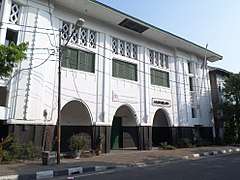Indonesia–Malaysia relations
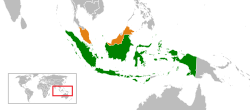 | |
Indonesia |
Malaysia |
|---|---|
| Diplomatic Mission | |
| Indonesian Embassy, Kuala Lumpur | Malaysian Embassy, Jakarta |
| Envoy | |
| Ambassador Rusdi Kirana | Ambassador Vacant |
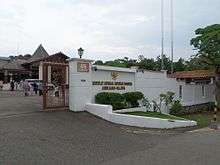
Indonesia–Malaysia relations (Indonesian and Malay: Hubungan Indonesia–Malaysia; Jawi: هوبوڠن إندونيسيا–مليسيا) are foreign bilateral relations between Indonesia and Malaysia, and it is one of the most important bilateral relationships in Southeast Asia.[1]
Indonesia and Malaysia are two neighbouring nations that share similarities in many aspects.[2] Both Malaysia and Indonesia have many common characteristic traits, these include common frames of reference in history, culture and religion. Although both countries are separate and independent states, there are also deeply embedded similarities.[3] Their national languages; Indonesian language and Malaysian language are closely related and mutually intelligible, both being standardised registers of Malay. The majority of the population of both nations were of Austronesian ancestry. Both nations are Muslim majority countries, the founding members of ASEAN and APEC, and also members of the Non-aligned Movement, Developing 8 Countries and Organisation of Islamic Cooperation.
Despite sharing so many similarities, tied by a common religion, language, proximity and a cultural heritage that dates back centuries, both nations have been lurching from one diplomatic spat to another.[4] Since independence Indonesia and Malaysia have moved in different directions in their social, economic, and political development, leading at times to serious bilateral tensions.[1] The unequal pace of democratization in the two countries over last decades has made the relationship increasingly problematic. Malaysian government-controlled media has been restrained in reporting sensitive issues involving Indonesia, on the other hand, Indonesia's liberal mass media has played a key role in inflaming the tension.[1]
Indonesia has an embassy in Kuala Lumpur and consulates general in Johor Bahru, George Town, Kota Kinabalu and Kuching.[5] Malaysia has an embassy in Jakarta and a consulates general in Medan, Pekanbaru and Pontianak.[6]
Country comparison
History

The History of Indonesia and History of Malaysia were often intertwined. Throughout their history the borders of ancient kingdoms and empires – such as Srivijaya, Majapahit, Malacca, Aceh and Johor-Riau – often comprised both modern-day countries. For centuries, the relations, migrations, and interactions between Indonesian and Malaysian people have been quite intense, and it is common for Malaysians to trace their relatives in Indonesia and vice versa. The Malays' homes are on both sides of the strait and also on coastal Borneo, while Dayak homelands are both in East Malaysian Borneo and Indonesian Kalimantan. Some of the Indonesian origin ethnic groups such as Minang, Bugis, and Javanese had significant migration to Malaysia and formed significant communities in Malaysia. Negeri Sembilan in particular have large numbers of Minangkabau people.
During the colonial era, the region was contested among European colonial powers, notably British and Dutch. From the 17th to early 19th century, various states, ports, and cities in the region were held as Dutch colonies or British possessions. The current borders between Indonesia and Malaysia were basically inherited from those established by the colonial powers through their treaties. The Anglo-Dutch Treaty of 1814 and 1824 significantly shaped the territories of Indonesia, Malaysia, Singapore, and India. These treaties officially divided the archipelago into two: Malaya, which was ruled by the United Kingdom, and the Dutch East Indies, which was ruled by the Netherlands. The successor states of Malaya and the Dutch East Indies are Malaysia and Indonesia, respectively. The line that separated the spheres of influence between the British and the Dutch ultimately became the border between Indonesia and Malaysia.
During World War II both British Malaya and Borneo together with the Dutch East Indies fell to the Japanese Empire. After the Japanese defeat, Indonesia declared its independence in 1945, followed a war of independence against Dutch until 1949. The British reestablished their authority in Malaya, and their withdrawal two decades later meant the independence of the states of Malaysia, Singapore, and Brunei. The diplomatic relations between the Republic of Indonesia and Federation of Malaya were established promptly after Malaya's independence from Britain in 1957.[9]
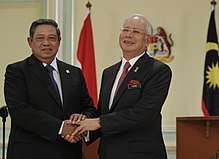
However, the relations between the two nations deteriorated under Indonesian President Sukarno in 1962 (see Indonesia–Malaysia confrontation, see Indonesian withdrawal from the United Nations). The conflict resulted from Indonesian opposition to the formation of Malaysia, a merger of the Federation of Malaya with two former British colonies on Borneo: Sarawak and Sabah. The conflict has led to the termination of diplomatic relations on 17 September 1963.[9]
After the fall of Sukarno, relations between Indonesia and Malaysia were restored under President Suharto; as both parties agreed to normalize the bilateral relationship and pursued peaceful co-operation and partnership. The bilateral relations recovery process was started on 1 June 1966 when the foreign ministers of two nations signed the Bangkok Accord to end hostility and confrontation. Followed by Jakarta Accord signed on 11 August 1966 in Jakarta, marked the re-establishment of bilateral relations. In September 1967 Indonesian Liaison Office was opened in Kuala Lumpur, led to the establishment of Indonesian embassy.[9]
In 1967, both countries together with Philippines, Singapore and Thailand founded ASEAN to ensure the peace and stability in the region. Since the 1970s under Suharto and Mahathir administrations, both countries enjoys relatively cordial and close relationship, stemmed from both proximity and serumpun (kinship) spirit. However, some diplomatic spats have occurred that at times put tensions on bilateral relations. These range from territorial disputes, treatment of migrant workers to accusations of cultural theft.
Territorial disputes
Most of the current borders were inherited from Dutch East Indies and British Malaya and Borneo colonial rule. Currently, both nations are in a territorial dispute over the oil-rich islands of Ambalat. Previously, they were over territorial disputes over the islands of Ligitan and Sipadan, which were won by Malaysia.[10]
The recent border disputes arisen in Straits of Malacca and South China Sea area mainly because the disagreement on exact locations of maritime naval borders in these waters. Both parties involved in arresting and detaining their counterpart's officials and fishermen accused on territorial breaching violations and illegal fishing.[11][12][13][14]
In August 2017, the Malaysian Insight claimed that according to an unnamed source, China will offer Malaysia advanced rocket launchers and a radar system to be based on the southern tip of the Southeast Asian country.[15][16] Up to 12 units of the AR3 multiple-launch artillery rocket system (MLRS) will be offered to Malaysia in a purchase program with a loan period of 50 years. The AR3 has a maximum range of up to 280 kilometers, a distance which will place some parts of Indonesia within firing range.[17] This was however denied by the Malaysian Armed Forces, citing they did not even receive any offers from China. The Chinese side also declined to comment on the report, saying "weapons exports were not part of its remit".[18]
Migrant workers
The Indonesian migrant worker (Indonesian: TKI abbreviation of Tenaga Kerja Indonesia) has become the important issue between both countries. In the 1980s to 1990s Malaysia saw the remarkable growth and development on economy, industrialization, and modernization. With its large population and large workforce, Indonesian jobseekers suddenly began to regard Malaysia as an attractive destination for work and improving their economic situation. In 1997 both Indonesia and Malaysia were hit by the financial crisis that prompted the fall of the Suharto regime. Indonesian suffered the worst, large amounts of Indonesians lost their jobs and a large influx of Indonesian jobseeker migrant workers began to pour into Malaysia, which in return caused social problems in Malaysia, such as competition for jobs, crime, and poverty.
The problems plaguing Indonesian migrant workers such as illegal immigration, crime, human trafficking, abuse, poor treatment and extortion upon migrant workers. Approximately 300,000 domestic workers, most of them from Indonesia, are employed in Malaysia. Many works up to 18 hours a day, seven days a week, for wages of 400 to 600 ringgit (US$118–177) a month and typically must turn over the first six to seven months of their salary to repay exorbitant recruitment fees. Some suffer physical or sexual violence from employers.[19] Since 2009, Indonesia has temporarily stopped sending domestic workers to Malaysia until both countries agree on ways to protect them. Indonesia resumes sending migrant workers to Malaysia in December 2011 as both countries sign a memorandum of understanding (MoU) about worker protection by the end of April 2011.[20]
Culture
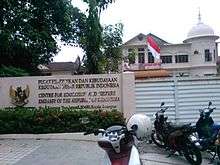
Because of many similarities and shared cultures between Indonesia and Malaysia—also because of significant numbers of Indonesian-origin immigrants in today's Malaysian demographic—both countries are often involved in disputes over cultural claims of the origin. Through an intensive tourism campaign, Malaysia has featured some famous cultural icons, namely the song Rasa Sayange, batik, shadow puppet theater and barongan (reog) dance.[21] This tourism promotion and cultural campaigns had alarmed and upset Indonesians that always thought that these arts and cultures belongs to them. As the reaction, many Indonesians felt the need to safeguard their cultural legacies, and to the extreme developed the anti-Malaysia sentiments. In 2009 the Pendet controversy fuelled again the cultural disputes among neighbours.[22] The advertisement promoting Discovery Channel's programme "Enigmatic Malaysia" featured Balinese Pendet dancer which it incorrectly showed to be a Malaysian dance.[23][24][25]
Disputes over the origins of a variety of dishes found in both countries is also a perpetual issue, from rendang[22] to lumpia (popiah). The claims to an extent also overlap with neighboring Singapore. Despite the dispute never leading to a serious confrontation between the two countries, and politicians of both sides having even acknowledged it as "petty", in Indonesia however, an activist group held a demonstration in front of the Malaysian Embassy in Jakarta to protest the origin of the dish, lumpia in February 2015.[26]
On the other hand, the shared language and culture have their own benefits on connecting the people of both countries. For example, Indonesian popular cultures such as Indonesian musics, films and sinetrons are popular in Malaysia. Numerous Indonesian bands and musicians have their fan-base in Malaysia and often performed some concerts in Malaysia. Vice versa Malaysian singers such as Sheila Majid and Siti Nurhaliza are beloved and popular in Indonesia. Malaysian animation Upin & Ipin with deep Malay culture had also gain wide popularity and appeal among Indonesian children and families.[27] However this cultural exchange is not always appreciated, the overwhelming popularity of Indonesian music in Malaysia had alarmed the Malaysian music industry. In 2008 Malaysian music industry demanded the restriction of Indonesian songs on Malaysian radio broadcasts.[28]
In addition, the two nations are fierce rivals in the international association football. Competitive matches between the Indonesian and Malaysian team are famed for their immense turnout and intense atmosphere, whether the tie is held in Malaysia or Indonesia.
Environment
The slash and burn practice to clear the lands for palm plantations in Sumatra and Kalimantan were causing haze and smoke fog that blown northwards by wind and had reached Malaysia and Singapore. The haze occurs in 1997, 2005, 2006, and reached the highest haze pollutant levels in June 2013.[29]
The haze is clearly hazardous for health and dangerous for transportation, especially flight safety in the region. The trans-border haze problems have strained diplomatic relations between Indonesia and Malaysia, and also with Singapore. The Malaysian and Singaporean government had noted their protest and urged the Indonesian government to reduce the hot-spots. In the peak of the haze that usually occur during dry season, Malaysian and Singaporean offer assistance to put off the fires. The Indonesian government had banned the slash and burn practice, however, the method was still widely used to clear palm oil plantation lands.
Another important environmental issue is transborder illegal logging. The Indonesian government has expressed the concern that many rainforests along Indonesia—Malaysia borders in Borneo were suffering illegal logging, mostly done by Malaysian loggers. The concern was aroused because Malaysian authorities seem to be doing nothing to prevent the crime and even seems to be encouraging this practice to increase Malaysian timber yield.
Media
Malaysians expressed their concern that media in Indonesia seems to encouraging and fostering the anti-Malaysia sentiments through distorted news coverages, exaggerations and blowing the issues beyond the proportions.[30] Malaysian government concerned about anti-Malaysia sentiments, protest and aggressive actions of certain extremists amids the bilateral spats over a Balinese dance and the mistreatment of Indonesian housemaids in Malaysia.[31] Malaysia government also stated had run out of patience and sent a protest letter to Indonesia after a demonstration triggered by a maritime dispute.[32]
On the other hands Indonesian media also had accused the government-controlled media in Malaysia to often presenting negative opinions and poor images on Indonesia and Indonesian people as the political agenda to prevent the Indonesian reformation and democratic movement to spill beyond its borders.[33] The government of Indonesia also had sent the notes of protest for Malaysian media on using the term indon to refer for Indonesia and Indonesian people that considered as derogatory.[34]
Education
As of December 2012, about 6,000 Malaysians are studying in Indonesia while about 14,000 Indonesians are studying in Malaysia.[35]
Trade and economy
Malaysian companies that are investing in Indonesia are Maybank, CIMB, Petronas, Tabung Haji, Proton Holdings and Sime Darby, as stated by the Yang di-Pertuan Agong in his message to Malaysians in Indonesia while he and the Raja Permaisuri Agong were on a state visit to Indonesia in December 2012.[36] Both countries are actively pursuing subregional economic co-operation to develop trans-border economic zones and free-trade areas that could generate regional economy, such as Sijori (Singapore-Johor-Riau) on the west and BIMP-EAGA on the east region. In December 2017, both countries alongside Thailand launched a framework to allow the use of local currencies in settlement of trade between them.[37]
Tourism
Because of their proximity, travellers from both countries are important source of visitors that generated travel and tourism industry. Indonesians are the second largest visitors for Malaysia, reaching 2,548,021 visitors in 2013.[38] On the other hand, Malaysians are also the second largest visitors for Indonesia, reaching 1,302,237 travellers in 2011.[39] The top visitors of both countries are Singaporean visitors. Kuala Lumpur, Malacca and Penang are popular destinations for Indonesian travellers, and vice versa Bandung, Medan and Bukittinggi are particularly popular among Malaysian tourist.
See also
- Indonesia–Malaysia border
- Indonesia–Malaysia confrontation
- East ASEAN Growth Area
- Sijori Growth Triangle
- Indonesia Raya (Melayu Raya)
- Maphilindo
- India–Pakistan relations, sometimes viewed as the closest version of Indonesia–Malaysia relations
References
- 1 2 3 Marshall Clark; Juliet Pietsch (18 March 2014). Indonesia-Malaysia Relations: Cultural Heritage, Politics and Labour Migration (Media, Culture and Social Change in Asia Series). Routledge. p. 11. ISBN 978-0-415687-52-2. Retrieved 6 July 2013.
- ↑ Emmanuel C. Alozie (23 March 2016). Advertising in Developing and Emerging Countries: The Economic, Political and Social Context. CRC Press. pp. 142–. ISBN 978-1-317-18498-0.
- ↑ Jennifer Sidharta (24 July 2016). "Here is Why Indonesia is Alike Malaysia, and Vice Versa". Global Indonesian Voices. Retrieved 7 September 2017.
- ↑ Luke Hunt (6 October 2010). "Love Thy Neighbour?". The Diplomat. Retrieved 18 June 2011.
- ↑ "Embassy of the Republic of Indonesia, Kuala Lumpur" (in Indonesian). Embassy of the Republic of Indonesia. Retrieved 8 September 2017.
• "Consulate General of Republic of Indonesia, Johor Bahru". Ministry of Foreign Affairs, Indonesia. Retrieved 8 September 2017.
• "Consulate General of Republic of Indonesia, Penang". Ministry of Foreign Affairs, Indonesia. Retrieved 8 September 2017.
• "Consulate General of Republic of Indonesia, Kota Kinabalu". Ministry of Foreign Affairs, Indonesia. Retrieved 8 September 2017.
• "Consulate General of Republic of Indonesia, Kuching". Ministry of Foreign Affairs, Indonesia. Retrieved 8 September 2017. - ↑ "Official Website of Embassy of Malaysia, Jakarta". Ministry of Foreign Affairs, Malaysia. Retrieved 8 September 2017.
• "Official Website of Consulate of Malaysia, Medan". Ministry of Foreign Affairs, Malaysia. Retrieved 8 September 2017.
• "Official Website of Consulate of Malaysia, Pekan Baru". Ministry of Foreign Affairs, Malaysia. Retrieved 8 September 2017.
• "Official Website of Consulate of Malaysia, Pontianak". Ministry of Foreign Affairs, Malaysia. Retrieved 8 September 2017. - ↑ CBS Estimate May 2015 - http://www.bps.go.id/linkTabelStatis/view/id/1274
- ↑ DS Estimate June 2014 - "Archived copy". Archived from the original on 11 May 2011. Retrieved 16 March 2014.
- 1 2 3 "Bilateral Cooperation – Malaysia". Ministry of Foreign Affairs, Indonesia. Archived from the original on 1 January 2016. Retrieved 29 October 2015.
- ↑ "The Court finds that sovereignty over the islands of Ligitan and Sipadan belongs to Malaysia". International Court of Justice. 17 December 2002. Archived from the original on 9 April 2014. Retrieved 7 February 2016.
- ↑ "Malaysian Police Arrests Indonesian Maritime Officers, Deny Shooting". Antara. Jakarta Globe. 15 August 2010. Archived from the original on 17 August 2010. Retrieved 18 June 2011.
- ↑ "Malaysia protests RI arrest of two fishing boats". The Jakarta Post. 10 April 2011. Archived from the original on 11 April 2011. Retrieved 18 June 2011.
- ↑ "14 RI military, police arrested in Malaysia". The Jakarta Post. 15 March 2015. Retrieved 7 September 2017.
- ↑ Jeremy Lanson (15 March 2016). "Sarawak fishermen missing after allegedly encroaching into Indonesian waters". The Borneo Post. Retrieved 7 September 2017.
- ↑ Jahabar Sadiq (9 August 2017). "Rocket launchers, radar system in Johor from China, with love". The Malaysian Insight. Retrieved 15 August 2017.
- ↑ Praveen Menon; Ben Blanchard; Sam Holmes; Paul Tait (9 August 2017). "China Offers Rocket Launchers, Radar System to Malaysia: Reports". Reuters. The New York Times. Retrieved 15 August 2017.
- ↑ Leslie Lopez; Lim Ai Leen (9 August 2017). "Malaysia, China exploring radar and missile system in Johor". The Straits Times. Retrieved 15 August 2017.
- ↑ Praveen Menon; Ben Blanchard; Sam Holmes; Paul Tait; Clarence Fernandez (10 August 2017). "Malaysia denies reports of offer for Chinese rocket launchers, radar". Reuters. Retrieved 15 August 2017.
- ↑ "Indonesia/Malaysia: Proposed Labor Pact Lacks Key Reforms". Human Rights Watch. United Nations High Commissioner for Refugees. 4 March 2010. Archived from the original on 18 October 2012. Retrieved 18 June 2011.
- ↑ "Indonesia to resume sending maids to Malaysia from Dec 1". Bernama. The Borneo Post. 21 October 2011. Retrieved 7 September 2017.
- ↑ "A never-ending story of cultural disputes between Indonesia and Malaysia". The Jakarta Post. 18 June 2012. Archived from the original on 20 June 2012. Retrieved 17 November 2015.
- 1 2 Jinn Winn Chong (2012). ""Mine, Yours or Ours?": The Indonesia-Malaysia Disputes over Shared Cultural Heritage". Journal of Social Issues in Southeast Asia. Academia.edu. pp. 1–53. doi:10.1355/sj27-1a. ISSN 1793-2858. Retrieved 19 November 2015.
- ↑ "Dozens protest Malaysia's claim over old Balinese old dance". The Jakarta Post. 22 August 2009. Archived from the original on 23 August 2009. Retrieved 18 June 2011.
- ↑ "Malaysia blames Discovery Channel in dance flap". The Jakarta Post. 4 September 2009. Archived from the original on 5 September 2009. Retrieved 18 June 2011.
- ↑ John M. Glionna (21 October 2009). "Indonesia vs. Malaysia: a cultural war". Los Angeles Times. Retrieved 18 June 2011.
- ↑ "Malaysia Vs. Its Neighbouring Countries- Will The Food Fight Ever End?". Malaysian Digest. 9 March 2015. Retrieved 19 November 2015.
- ↑ Lisa Siregar (5 September 2010). "Upin and Ipin Win Hearts and Minds". Jakarta Globe. Retrieved 8 June 2011.
- ↑ "Malaysian music industry wants Indonesian songs restricted". The Jakarta Post. 3 September 2008. Archived from the original on 24 December 2009. Retrieved 18 June 2011.
- ↑ "Singapore hit by highest haze levels in 16 years". BBC News. 18 June 2013. Retrieved 20 June 2013.
- ↑ "Anti-Malaysia protests not likely to end anytime soon". The Star. 27 August 2010. Retrieved 18 June 2011.
- ↑ "Malaysia urges Indonesians not to damage relations". Associated Press. The Jakarta Post. 10 September 2009. Archived from the original on 11 September 2009. Retrieved 18 June 2011.
- ↑ "Malaysia 'out of patience' after Indonesia protests". Agence France-Presse. AsiaOne. 25 August 2010. Retrieved 18 June 2011.
- ↑ Erwida Maulia (26 September 2010). "Anwar blames M'sian media, ruling party for tension with Indonesia". The Jakarta Post. Archived from the original on 30 September 2010. Retrieved 18 June 2011.
- ↑ "'Indon' Article Prompts Protest". Antara. Jakarta Globe. 4 February 2011. Archived from the original on 6 February 2011. Retrieved 18 June 2011.
- ↑ "King, queen conclude four-day state visit to Indonesia". Bernama. The Borneo Post. 7 December 2012. Retrieved 7 September 2017.
- ↑ "Uphold the good name of Malaysia in Indonesia, says King". Bernama. The Star. 6 December 2012. Retrieved 7 September 2017.
- ↑ "Indonesia, Malaysia and Thailand seek to boost local currency settleme". Reuters. 11 December 2017. Retrieved 24 December 2017.
- ↑ "Malaysia Tourist Arrivals by Country of Nationality December 2013" (PDF). Tourism Malaysia. December 2013. Archived from the original (PDF) on 28 October 2014. Retrieved 19 January 2015.
- ↑ "Jumlah Kedatangan Wisatawan Mancanegara ke Indonesia Menurut Negara Tempat Tinggal 2002-2011" (in Indonesian). Statistics Indonesia (Badan Pusat Statistik). Archived from the original on 2 February 2012. Retrieved 31 January 2013.
Further reading
- Marshall Alexander Clark; Juliet Pietsch (2014). Indonesia-Malaysia Relations: Cultural Heritage, Politics and Labour Migration. Routledge. ISBN 978-0-415-68752-2.
- Md. Khalid, K.; Yacob, S. (2012). "Managing Malaysia-Indonesia relations in the context of democratization: the emergence of non-state actors". International Relations of the Asia-Pacific. 12 (3): 355–387. doi:10.1093/irap/lcr024. ISSN 1470-482X.
- Joseph Chinyong Liow (2005). The Politics of Indonesia-Malaysia Relations: One Kin, Two Nations. Psychology Press. pp. 148–. ISBN 978-0-415-34132-5.
- Jennifer Sidharta (2015). "Indonesia and Malaysia: Related by Blood". Global Indonesian Voices.




